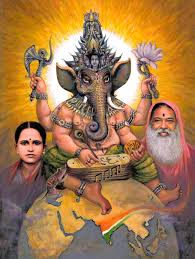Pluck a blade of grass and observe it closely. It is so lovely, tiny and cute. It possesses a nature to spread easily. Hence it is all-pervading, it cannot be destroyed, it does not harm anyone many and more importantly, it offers shelter to many tiny insects that grow under its shade.
At all times with its pointed ends it looks upwards. The edges are so sharp and pointed that it appears as if we cannot see its end point very clearly. Each blade is pure and thus symbolizes purity. When faced with heavy winds, it bend easily reflecting its humility. Being both humble and pure, with its single pointed end it is eternally focusing on akasha (space).
This grass is also an herb that not only aids in curing physical ailments but also aids the mind and the buddhi (intellect). Due to its innumerable good traits, Ganapati loves garika grass. Through its various good qualities, it teaches us the goal of life and how to lead life.
What about sugarcane? Sugarcane is used not only for decorations around the idol during the puja but it is also offered to the Lord during the puja. Its juice is offered to the Lord.
Offering sugarcane has a deep symbolism and significance. Sugarcane represents the human body. Its joints are the joints within our body (sandhis). The leaves on the top symbolize our hair. The roots are our feet. The outer surface is the skin. The lengthy fibrous content within is our muscular system. The juice is the blood within us.
From another viewpoint, the outer skin also represents our ego. With a lot of effort when this ego (skin) is scraped off, the white fibrous flesh within reflects our tender heart. The heart devoid of the ego is itself the universal form of the Lord. Such heart is then in a position to grasp the vibrations (spandana) from Lord Ganapati and understand Him.
Breaking the cane into pieces and chewing it to drink in the sweet juice represents the tough spiritual practices that are undertaken to reach this state. Due to the intense spiritual practices, the aspirant is rewarded with nectar.
Let us now understand the symbolism behind his form.
His elephant head symbolizes limitless strength. It emphasizes that He is one who cannot be defeated. His large head symbolizes His wisdom. Small eyes show that He can see things far away and understand all happenings minutely with His foresight.
The large ears display His ability to hear in great detail everything that is expressed. The ‘pasha’ (noose) shows that maya or illusion is under His control. ‘Ankusha’ (goad) states that ego is under His control. The single tusk depicts the ultimate victory –the one from which there is no return.
His big stomach contains in it all the secrets. It is the womb in which the entire universe rests. The snake is the sleeping Kundalini. Ganapati sitting or standing on the rat implies He drives away the spiritual ignorance. The existence of both the rat and the snake near Him teaches that in his presence a person gives up jealousies, enmities and hatred and lives in peace and harmony.
-Bhaktimala
